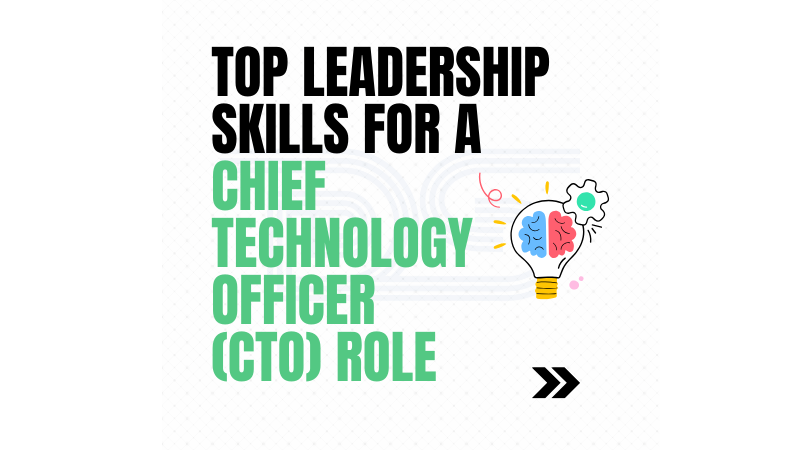
by DharamCW | Apr 24, 2025 | General, Project Management, Project-Program-Portfolio Management Knowledge
🔍 Top Leadership Skills for a Chief Technology Officer (CTO) Role
The role of a CTO goes far beyond just overseeing technology.
✅ Driving innovation
✅ Aligning tech with business goals
✅ Leading technical teams with expertise and vision
Here are 4 key leadership skills every aspiring or current CTO must master:
1️⃣ Mastering Strategic Thinking
Anticipate trends, align technology with business goals, and drive growth through informed decisions.
2️⃣ Excelling in Communication and Collaboration
Align stakeholders, inspire teams, and simplify technical concepts into actionable insights.
3️⃣ Staying Ahead with Technical Expertise
Balance leadership with up-to-date knowledge to drive innovation and maintain a competitive edge.
4️⃣ Leading and Developing High-Performing Teams
Empower employees, foster growth, and build a positive, performance-driven culture.
💬 Which of these skills do you believe is most critical for a CTO today?
Comment below and let’s spark a conversation.
🔁 Don’t forget to Like, Share, and Save this post if you found it insightful.
🔗 Want to explore more?
View our upcoming PgMP Programs
Online Training → http://bit.ly/2oBKQXQ
Direct Training → http://bit.ly/2oCfpg0
Explore Our PfMP Programs:
Online Training → http://bit.ly/39jOZSf
Direct Training → http://bit.ly/38er2M3
📞 For queries: +1 650-283-0123
🎥 Free Consultation with Me: https://lnkd.in/gwD-52JH
#CTO #LeadershipSkills #StrategicThinking #TechLeadership #Innovation #HighPerformingTeams #vCareProjectManagement #DharamSingh #TechnologyLeadership #BusinessStrategy #DigitalTransformation #ExecutiveLeadership #TeamDevelopment #CLevelSkills #CTORole #TechVision #InspireTeams #TechManagement #FutureLeadership #CTOSuccess
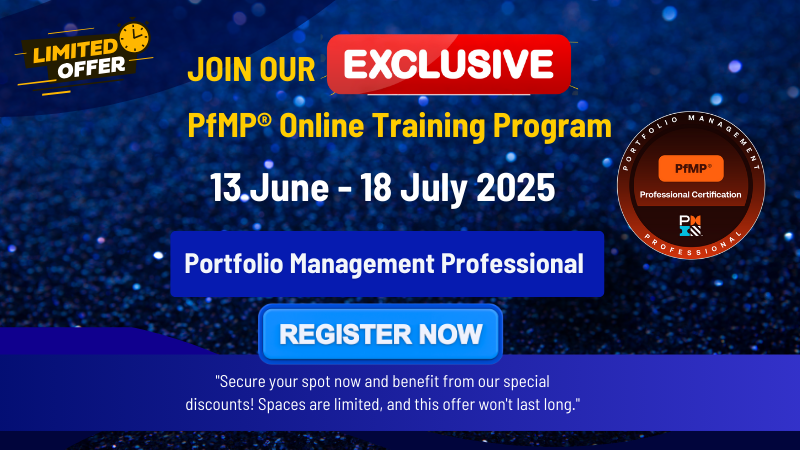
by DharamCW | Apr 23, 2025 | vCare PMI Certification Training Classes
🚀 Fast-Track Your PfMP® Success in Just 6 Weeks!
I am thrilled to invite you to our upcoming PfMP® Online Group Mentoring Program – a result-driven journey designed to guide you toward achieving the globally recognized Portfolio Management Professional (PfMP®) credential.
📌 Registration Link: http://bit.ly/3leFAql
🔹 Program Duration: 13 June – 18 July 2025
🔹 Time: 10:00 AM – 12:00 PM EDT (Live Online Sessions)
🔹 Mentor: Dharam Singh (PfMP, PgMP, PMP, PMI-ACP, SP, PBA, RMP, DASM, DASSM, PMI-ATP)
🌟 Program Highlights:
✔️ Comprehensive coverage aligned with PMI’s PfMP® Standard (SPMv3)
✔️ PfMP® Complete Reference Guide & Mapping Workbook (SPMv3)
✔️ Exclusive access to PfMP® Challenger Mock Exam #1
✔️ Personalized Mentorship for Application, Audit, and Panel Review
✔️ 10 Instructional Videos + 48 PDUs/Contact Hours
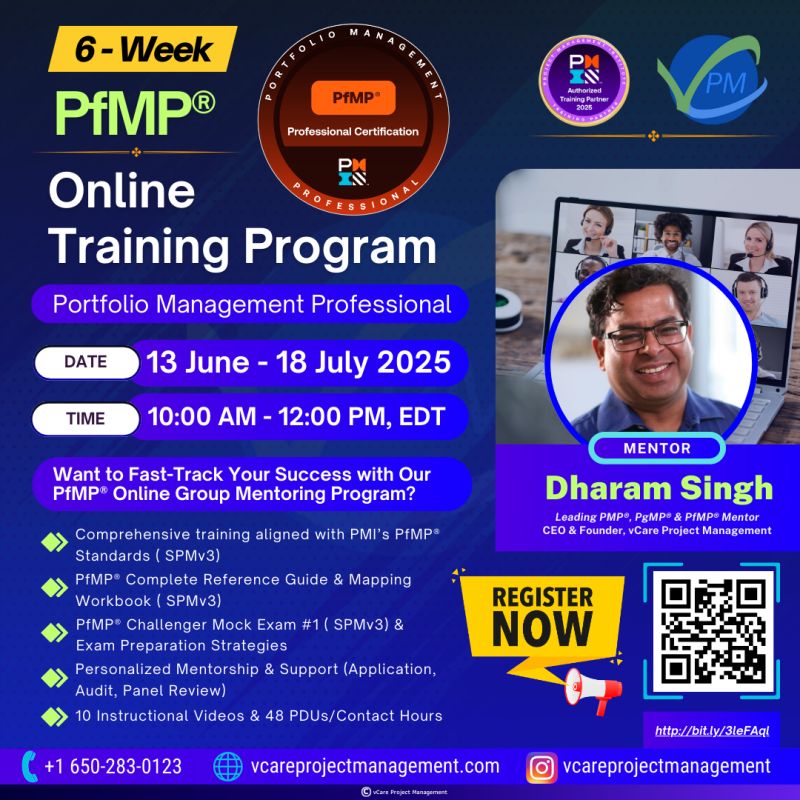
PfMP Online Mentoring Program 2025 flyer highlighting session dates, mentor Dharam Singh, and certification benefits.
💡 Why Join?
Whether you’re beginning your PfMP® journey or striving to confidently pass the exam, this program equips you with practical knowledge, proven exam strategies, and personalized support for accelerated success.
📌 Explore Our PfMP® Programs:
Online Training → http://bit.ly/39jOZSf
Direct Training → http://bit.ly/38er2M3
📌 Join Our PfMP® Community:
PfMP4U LinkedIn Group → http://bit.ly/31P7GKR
📌 Essential PfMP® Study Materials:
PfMP Pathfinder – https://bit.ly/35j9Dli
The Complete Reference Guide for PfMP Certification – https://bit.ly/3pU4ud5
PfMP Challenger Mock Exam 1 | Exam Simulator – https://bit.ly/3KKZkv3
PfMP Challenger Mock Exam 2 | Exam Simulator – https://bit.ly/3VlI5FH
PfMP Challenger Mock Exam 3 | Exam Simulator – https://bit.ly/3VNrfRL
PfMP Challenger Gold (Mock Exams 1 to 3) | Exam Simulator – https://bit.ly/3KCjbNh
🗣️ Need guidance?
Book a free consultation here → http://talktodharam.com
📲 Register Now for Exclusive Offers!
Scan the QR code or visit: https://www.vcareprojectmanagement.com
📞 Contact: 650 283 0123
#PfMP #PfMPTraining #PortfolioManagement #PfMPExamPrep #ProjectManagement #PMICertification #PfMPMentoring #vCareProjectManagement #DharamSingh #PMI #PMIATP #PfMP2025 #PortfolioManager #StrategicExecution #MentorshipMatters #LeadershipDevelopment #OnlineTraining #ProfessionalGrowth #PfMPCertification #PfMPBootcamp

by DharamCW | Apr 22, 2025 | vCare PMI Certification Training Classes
🚀 Ready to elevate your portfolio leadership skills and earn your PfMP® certification? Join me in Dallas from June 27–29, 2025 for an immersive, in-person PfMP® Bootcamp from vCare Project Management!
This 3-day session is tailored for professionals looking to master Portfolio Management and align their strategies with business value. Whether you’re already managing portfolios or aspiring to transition into this role, this program equips you with the tools, frameworks, and expert insights needed to succeed.
📍Location: Dallas, TX
🗓️ Dates: June 27 – 29, 2025
⏰ Timing: 9 AM – 5 PM (CDT)
🔗 Register Now: https://bit.ly/3ByLdrs
🔍 What You’ll Gain:
✅ PfMP® Complete Reference Guide
✅ PfMP® Pathfinder: Mapping ECO Task
✅ PfMP® Mapping Workbook
✅ 48 PDUs/Contact Hours
✅ Direct mentoring from me, with real-world examples and case discussions
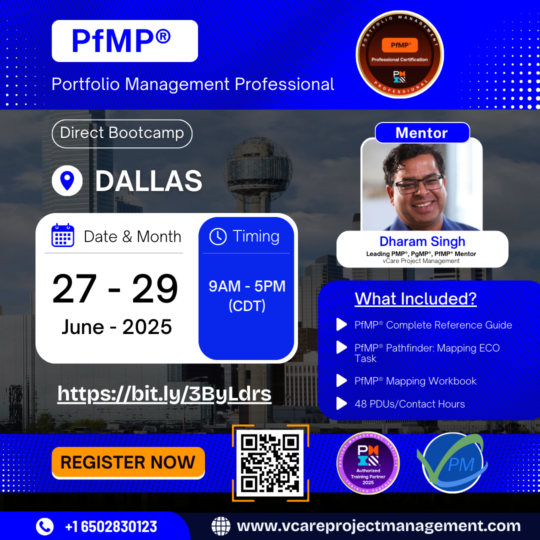
Level up your portfolio leadership skills—join the PfMP Bootcamp in Dallas this June with expert guidance from Dharam Singh.
This is more than a class – it’s your step toward becoming a strategic driver of change.
📌 Explore Our PfMP® Programs:
Online Training → http://bit.ly/39jOZSf
Direct Training → http://bit.ly/38er2M3
📌 Join Our PfMP® Community:
PfMP4U LinkedIn Group → http://bit.ly/31P7GKR
📌 Essential PfMP® Study Materials:
PfMP Pathfinder – https://bit.ly/35j9Dli
The Complete Reference Guide for PfMP Certification – https://bit.ly/3pU4ud5
PfMP Challenger Mock Exam 1 | Exam Simulator – https://bit.ly/3KKZkv3
PfMP Challenger Mock Exam 2 | Exam Simulator – https://bit.ly/3VlI5FH
PfMP Challenger Mock Exam 3 | Exam Simulator – https://bit.ly/3VNrfRL
PfMP Challenger Gold (Mock Exams 1 to 3) | Exam Simulator – https://bit.ly/3KCjbNh
📞 For queries: +1 650-283-0123
🎥 Free Consultation with Me: http://talktodharam.com
Looking forward to welcoming you in Dallas!
#PfMP #PfMPCertification #PortfolioManagement #vCareProjectManagement #DharamSingh #DallasBootcamp #PMITrainingPartner #StrategicExecution #PfMPTraining #June2025 #PMICertification #Leadership #Mentoring #BootcampAlert #DirectBootcamp #PfMPWorkshop #PfMPExamPrep #PfMPChallenger #PfMPPathfinder #PfMPWorkbook #PMOLeadership
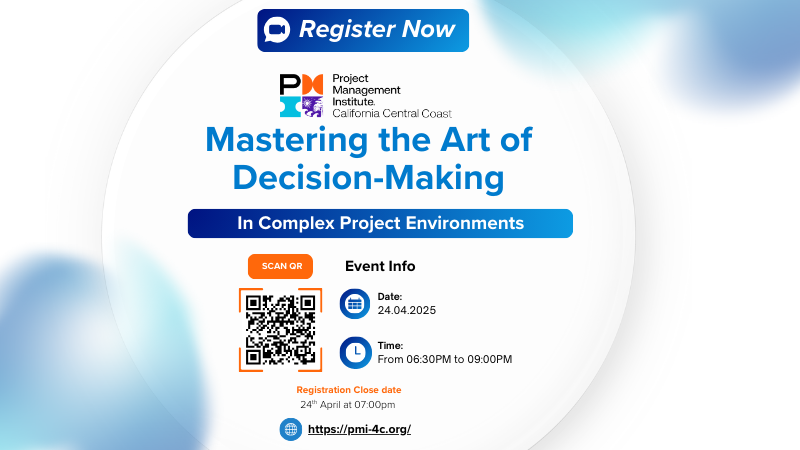
by DharamCW | Apr 22, 2025 | Industry Trends and Insights, Leadership in Project Management, Professional Development Webinars
🌐 Excited to be Speaking at PMI California Central Coast Chapter!
🎯 Topic: Mastering the Art of Decision-Making in Complex Project Environments
Date: 24th April 2025
Time: 6:30 PM to 9:00 PM PDT
📍 Register Now: https://pmi-4c.org/event-registration?eventId=41145
In today’s fast-changing project environments, the ability to make timely, informed, and strategic decisions is more vital than ever. I’m thrilled to join fellow professionals at PMI-4C to dive deep into the evolving landscape of project decision-making and explore the tools, trends, and tactics that drive better project outcomes.
💡 Key Agenda Points:
– Understanding the Decision-Making Landscape
– Tools & Techniques for Better Decisions
– Emerging Trends in 2025 & Beyond
– Stakeholder Engagement in Decision-Making
– Key Strategies for Future-Ready Organizations
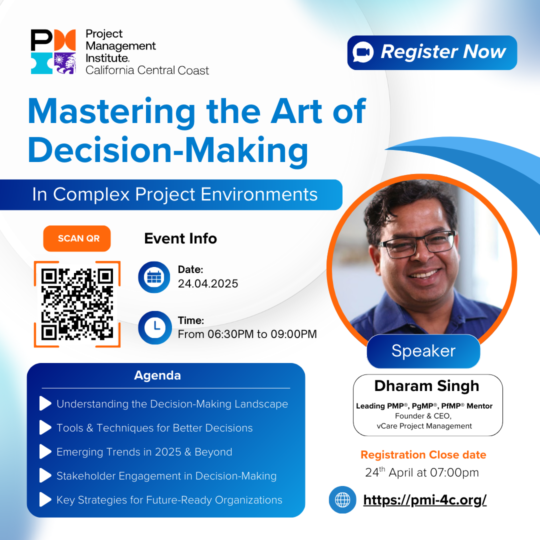
Dharam Singh to speak at PMI California Central Coast on mastering decision-making in complex project environments
📌 Whether you’re a project, program, or portfolio leader, this session will help sharpen your decision-making skills and better prepare your teams for complexity and change.
Let’s decode complexity and lead with clarity.
Looking forward to seeing you there!
View our upcoming PgMP® Programs
Online → http://bit.ly/2oBKQXQ
Direct → http://bit.ly/2oCfpg0
View our upcoming PfMP® Programs:
Online → http://bit.ly/39jOZSf
Direct → http://bit.ly/38er2M3
🎙️ Got questions about your Project Management career or PMI certifications?
Book your FREE 15-min session with me at 👉 www.talktodharam.com
📞 Contact Us
📱 Call: +1 650-283-0123 (U.S.)
📧 Email: info@vcareprojectmanagement.com
🎧 Subscribe & Stay Ahead
Webinars & Success Stories: https://bit.ly/2YF0wJl
Podcasts & Interviews: https://bit.ly/2NDY8wd
#ProjectManagement #DecisionMaking #Leadership #PgMP #PfMP #PMP #vCareProjectManagement #PMI4C #StrategicThinking #FutureReady #DharamSingh
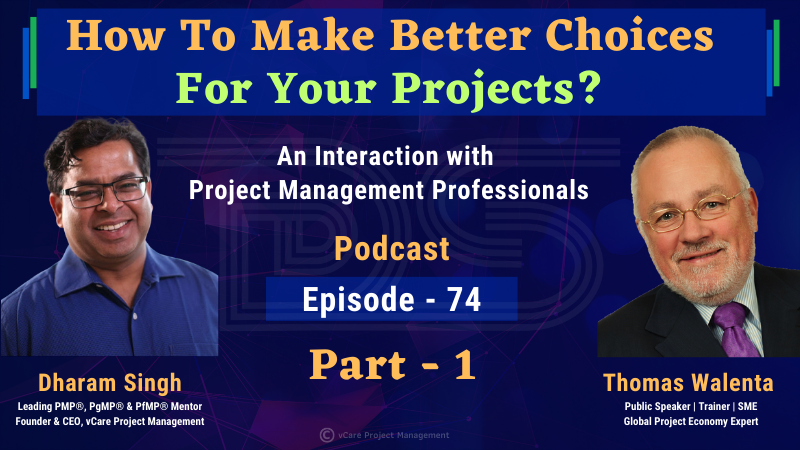
by DharamCW | Apr 18, 2025 | Leadership in Project Management, Professional Development Webinars
How To Make Better Choices For Your Projects | Part 1
As project managers, our ability to make the right decisions at the right time can define the success or failure of our initiatives. In this insightful conversation with PMI Fellow Thomas Walenta, we dive deep into the art of decision-making in today’s dynamic project landscape.
With 40+ years of experience, Thomas shares practical advice, proven strategies, and eye-opening examples on how to align decisions with project goals, stakeholder expectations, and long-term value.
Watch Now: https://youtu.be/Re-CLabsvUw
🎯 Key Discussion Topics:
✔️ The importance of making informed choices in today’s evolving project environments
✔️ Strategic vs. operational decisions – understanding the difference and impact
✔️ How data analytics empowers smarter decisions – tools & techniques that work
✔️ Risk-based decision making – real-world scenarios that shaped outcomes
🎧 Tune in to Part 1 of this insightful episode and elevate the way you lead your projects!
📞 Book a 15-minute discovery session: talktodharam.com
📚 Resources to advance your certification journey:
👉 PgMP & PfMP: https://bit.ly/3HL1HMY
👉 PgMP Q&A Series: https://bit.ly/2Yo7EvQ
👉 PfMP Q&A Series: https://bit.ly/3BORnPq
Contact Us:
Call us: +1 650-283-0123 (U.S.)
Email: info@vcareprojectmanagement.com
Subscribe for More:
Success Stories https://bit.ly/2YF0wJl
Podcasts and Interviews: https://bit.ly/2NDY8wd
#projectmanagement #projecteconomy #pmi #thomaswalenta #pgmp #projectmanager #agilemanagement #dharamsinghpgmp #pmicertifications #PMP #projectmanagementprofessional #programmanagementprofessional #pgmptraining #pfmptraining #pmptraining #AI #decisionmaking #leadership










Recent Comments